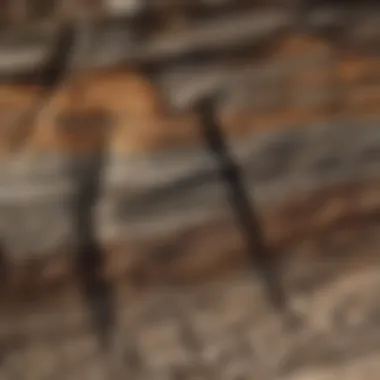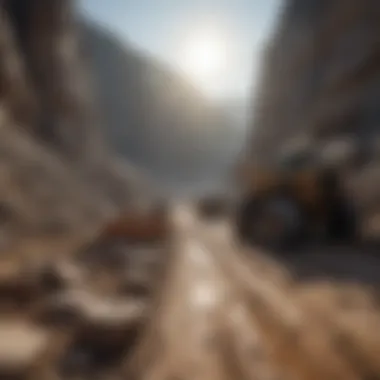Unveiling the Enigmatic World of Shale Rock: Origins, Composition, and Significance


Rock and Fossil Identification
Shale rock, a key player in the geological landscape, exhibits distinctive characteristics that set it apart from other rock types. Focusing on identifying shale involves recognizing its fine-grained texture, often layered appearance, and ability to split into thin sheets. Utilizing tools such as hand lens and hammer proves invaluable in pinpointing these features, aiding enthusiasts in confidently distinguishing shale from its counterparts.
Geological Insights
Navigating the depths of shale rock unveils a world colored by geological processes that date back millions of years. From the sedimentary layers where shale originates to its role in recording historical events through fossil imprints, each formation provides a window into the Earth's past. Notable discoveries within shale formations have shed light on ancient ecosystems and climatic conditions, offering scholars and enthusiasts profound insights into the planet's evolution.
Introduction to Shale Rock
In the vast realm of geology, Shale Rock stands as a captivating subject of study, offering insights into Earth's history and environmental significance. As the foundational segment of this article, 'Introduction to Shale Rock' sets the stage for a comprehensive exploration into this enigmatic material. Shale Rock's defining characteristics, origins, and relevance in geological processes will be meticulously dissected, providing rock and fossil enthusiasts with a profound understanding of its importance in scientific discourse and practical applications.
Defining Shale Rock
The Composition of Shale
Shale's composition holds a crucial role in its identification and usage. Comprised primarily of fine-grained sedimentary particles, including clay minerals and quartz, shale possesses unique properties that render it ideal for geological investigations and various industrial purposes. Its high clay content contributes to its ability to retain water and resist weathering, making it a resilient material in both natural and engineered settings.
Physical Characteristics
Shale's physical characteristics, such as its fissility and smooth texture, not only aid in distinguishing it from other rock types but also highlight its role in sedimentary processes. Its layered structure allows for easy splitting, a feature that has garnered attention in construction and architectural fields. Understanding these physical attributes illuminates the multifaceted nature of shale and underscores its versatility across diverse disciplines.
Origins and Formation
Exploring the origins and formation of shale unveils a narrative of Earth's geological evolution. Shale's sedimentary genesis, often linked to ancient marine environments rich in organic matter, offers valuable insights into past climates and ecosystems. The intricate processes of compaction and cementation over millions of years transform sediment into the solid rock we recognize today, reflecting the enduring nature of shale within Earth's geological tapestry.
Geological Significance


Impact on the Earth's History
Shale Rock's impact on Earth's history transcends mere geological curiosity, providing a chronicle of planetary events and transformations. Its extensive deposition throughout epochs reveals shifts in climate, tectonic activities, and even biological evolution, making it a crucial archive for understanding past environments and geological events.
Role in Sedimentary Processes
Shale's role in sedimentary processes unveils its central position in Earth's crust dynamics. Acting as a key player in the formation of sedimentary basins and depositional environments, shale influences the distribution of minerals, fossils, and hydrocarbons, shaping the intricate tapestry of Earth's surface geology.
Relation to Other Rock Types
Examining shale's relation to other rock types underscores its interconnectedness within Earth's lithosphere. From interbedded formations with sandstone to transitional sequences with limestone, shale showcases a symbiotic relationship with diverse rock compositions, offering geologists a window into the complex layering and deposition processes that have sculpted our planet over millennia.
Exploration of Shale Deposits
Global Distribution
Shale deposits exist in various regions worldwide, showcasing a wealth of geological diversity and resource potential. From the vast sedimentary basins of North America to the ancient deposits of Europe and Asia, shale's global distribution mirrors Earth's geological history and tectonic evolution. Studying these diverse occurrences provides invaluable insights into regional geology and resource exploitation possibilities.
Notable Shale Formations
Certain shale formations stand out for their unique geological features and historical significance. Whether it's the iconic Marcellus Shale in the Appalachian Basin or the prolific Barnett Shale in Texas, these notable formations have shaped our understanding of shale's depositional environments, fossil assemblages, and hydrocarbon reservoir potentials. Investigating these renowned formations sheds light on the diverse facets of shale geology.
Economic Importance
Shale's economic importance extends beyond its geological value, encompassing a wide range of industrial applications and resource extraction opportunities. The exploitation of shale oil and gas reserves, the utilization of shale as a construction material, and its potential for environmental remediation projects underscore its multifaceted economic significance. Delving into these economic dimensions illuminates shale's role in sustainable development and resource management strategies.
Formation Processes
In this section of the article, we delve deep into the crucial aspect of Formation Processes concerning shale rock. Understanding the formation processes is essential in gaining insights into the intricate world of shale rocks. We focus on specific elements such as sediment accumulation, compaction, cementation, diagenesis, and lithification. By exploring these processes meticulously, we can unravel the mysteries surrounding the origins and properties of shale rocks, providing a comprehensive guide for enthusiasts, researchers, and geologists.


Sediment Accumulation
Shale Formation in Aquatic Environments
Exploring the shale formation in aquatic environments reveals a fascinating aspect of the geological processes. The gradual accumulation of fine sediment particles in water bodies over millions of years leads to the formation of shale rocks. This unique process embeds clues about ancient environments and ecosystems, offering a valuable window into Earth's history. The preservation of microorganisms and organic materials in aquatic shale deposits contributes significantly to the understanding of past life forms and environmental conditions.
Impact of Organic Matter
The impact of organic matter on shale formation is a critical element that influences the composition and characteristics of shale rocks. Organic matter, such as decaying plant materials and ancient organisms, plays a crucial role in the transformation of sediment into shale through complex biological and chemical processes. The presence of organic components contributes to variations in color, texture, and porosity in shale rocks, making them essential sources of information for paleontologists and geologists.
Factors Influencing Deposition
Various factors influence the deposition of sediments that eventually form shale rocks. Environmental conditions, tectonic movements, climatic changes, and sediment sources all play significant roles in the accumulation and preservation of shale deposits. Understanding these factors provides insights into the geographical distribution, structural characteristics, and geological significance of shale formations. By analyzing the factors influencing deposition, researchers can reconstruct past environments and interpret the evolution of landscapes over geological timescales.
Characteristics and Properties
Shale rock's characteristics and properties play a pivotal role in understanding its composition and applications within the geological domain. The texture and coloration of shale hold significant importance in discerning its structural nuances and identifying key features. Exploring the fine-grained structure provides a deeper insight into shale's internal makeup, highlighting its compact nature and intricate layering. The variations in color aid in distinguishing different shale formations, with hues ranging from earthy tones to deeper shades, signifying mineral variations and environmental conditions. Identification features offer valuable clues for geologists and researchers, enabling them to classify shale types based on distinct patterns and mineral compositions.
Texture and Coloration
Fine-grained structure
The fine-grained structure of shale rock is a standout feature that contributes to its overall composition and physical attributes. This compact structure consists of densely packed particles, offering excellent insights into sedimentary processes and historical formations. Its smooth texture and layered appearance make it a preferred choice for detailed mineralogical studies and stratigraphic analysis. Despite its cohesive nature, fine-grained shale allows for intricate delineation of sedimentary sequences and organic matter entrapment, crucial for understanding ancient environments and depositional settings.
Variations in color
Shale's variations in color serve as a visual cue for geologists, indicating mineral variations, oxidation states, and environmental conditions during deposition. From light grey to dark black hues, the color spectrum of shale reflects different sediment sources, organic content, and diagenetic processes. These color variations provide essential information on the mineralogy and potential resource richness of shale formations, guiding both scientific research and industrial applications.
Identification features


Identifying distinctive features within shale formations aids in categorizing different rock types and understanding their mineralogical properties. Through specific markers such as fossil imprints, mineral inclusions, or bedding structures, geologists can determine the depositional history, age, and tectonic influences on shale rocks. These identification features are crucial for geological mapping, resource exploration, and environmental assessments, paving the way for informed decision-making and sustainable utilization of shale resources.
Porosity and Permeability
Shale rock's porosity and permeability characteristics have profound implications on fluid flow dynamics, industrial applications, and environmental considerations. The effects of fluid flow within shale matrices dictate resource extraction processes, groundwater interactions, and subsurface fluid movements. Understanding the unique porosity of shale formations enables efficient utilization in various industries such as oil and gas exploration, water management, and geotechnical engineering. Shale's intrinsic water retention properties provide resilience against drought conditions, supporting ecological balance and sustainable land use practices.
Mechanical Strength
The mechanical strength of shale rock influences its engineering applications, construction viability, and long-term durability. Considerations such as bedding orientation, rock mass integrity, and fracture patterns impact the stability and load-bearing capacity of shale formations in construction projects. The use of shale in structural elements requires rigorous assessment of its mechanical properties to ensure structural integrity and longevity. Despite its inherent brittleness, shale exhibits remarkable durability over time when appropriately engineered and monitored, making it a valuable material for long-lasting infrastructural developments.
Environmental Impacts and Uses
In the realm of shale rock exploration, the discussion of environmental impacts and uses holds a paramount importance. Understanding the environmental repercussions and practical applications of shale rock is crucial for a comprehensive insight into this geological material. By delving into the aspects of erosion, weathering, industrial applications, and environmental remediation associated with shale rock, we can unravel its full potential and significance.
Erosion and Weathering
Vulnerability to natural processes
When it comes to the vulnerability of shale rock to natural processes, a unique characteristic emerges that plays a significant role in shaping the landscape. The susceptibility of shale to erosion and weathering highlights its delicate nature in the face of natural forces. This vulnerability, while posing challenges, also offers insights into the geological resilience of shale formations. Exploring the nuances of how shale interacts with erosion and weathering can provide valuable information on land morphology and evolution over time. Understanding this aspect enhances our comprehension of the dynamic interplay between shale rock and its surrounding environment.
Land degradation issues
The discussion on land degradation associated with shale rock sheds light on the complex environmental challenges posed by its exploitation. Addressing land degradation issues is essential for sustainable land use practices and ecosystem preservation. By examining how shale activities contribute to land degradation, we can implement mitigation strategies and regulatory measures to minimize environmental harm. Analyzing the impact of shale industries on land degradation offers insights into potential areas of improvement and sustainable resource management practices. This thorough examination allows us to appreciate the delicate balance between industrial development and environmental conservation.
Stability concerns
Stability concerns related to shale rock usage encompass a range of considerations vital for long-term environmental sustainability and safety. Evaluating the stability of shale formations and structures requires a detailed analysis of geotechnical factors and engineering principles. Assessing the stability concerns associated with shale operations enables us to mitigate risks and enhance safety measures in industrial applications. Understanding the unique characteristics of shale that influence stability is crucial for making informed decisions regarding construction projects and environmental management strategies. By addressing stability concerns proactively, we can ensure responsible utilization of shale resources while safeguarding ecological integrity.
Industrial Applications
Exploring the diverse industrial applications of shale rock unveils a world of possibilities for resource utilization and economic development. The extraction of shale oil and gas represents a significant sector that relies on shale reserves for energy production. Understanding the intricacies of shale oil and gas extraction processes is key to maximizing resource efficiency and minimizing environmental impacts. Utilizing shale as a source of building materials showcases its versatility and durability in construction projects. By examining the unique features and advantages of employing shale in construction, we can foster sustainable building practices and innovative architectural designs. Considering environmental considerations in shale-related industries is a fundamental component of responsible resource utilization and pollution prevention. By integrating environmentally conscious practices into shale operations, we can promote a sustainable approach to industrial development and natural resource management.
Environmental Remediation
The realm of environmental remediation in the context of shale rock offers solutions to mitigate ecological damage and restore disturbed areas to their natural state. Engaging in land reclamation projects involving shale sites requires a strategic approach to ecosystem restoration and conservation. By delving into pollution mitigation strategies specific to shale-related activities, we can address environmental challenges effectively and safeguard ecosystem health. Implementing rehabilitation measures for disturbed areas impacted by shale operations entails adopting innovative techniques and best practices in environmental restoration. By focusing on the unique features of rehabilitation processes and their advantages, we can enhance the sustainability of land reclamation initiatives and minimize environmental degradation. This comprehensive exploration of environmental remediation highlights the importance of promoting ecosystem resilience and environmental stewardship in the realm of shale rock utilization.







